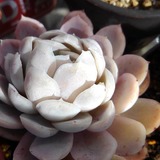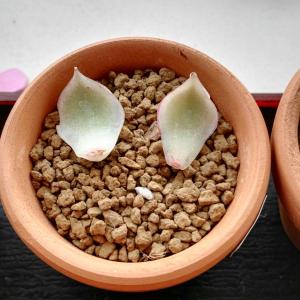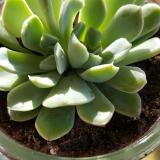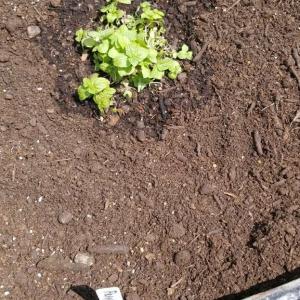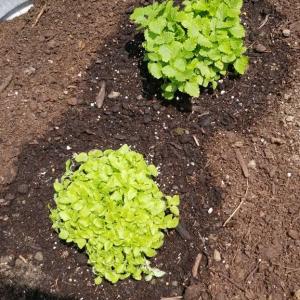文章
Miss Chen
2018年05月28日

Description: This herbaceous plant is about 1½–4½' tall, branching occasionally. It is a biennial or short-lived perennial. The erect to ascending stems are light green to dull reddish brown, terete, and densely covered with long hairs. The alternate or opposite leaves are up to 12" long and 8" across, becoming gradually smaller as they ascend the stems. They have pubescent petioles up to 4" long that are grooved above and convex below. The lower to middle leaves are pinnately lobed and somewhat dentate or undulate along their margins; they usually have 5-7 major lobes with pointed tips. The upper leaves have pairs of basal lobes or they lack lobes; they are ovate, broadly hastate, or sometimes another shape.
The upper leaf surface is dull medium green; it is usually hairless for older leaves and appressed-hairy for younger leaves. The lower leaf surface is pale green and pubescent primarily along the major veins. At the bases of petioles, there are pairs of large green stipules. These stipules are connate (merged together) and their margins are coarsely dentate. Small cymes of several flowerheads develop from the upper stems and the axils of upper leaves. The branches of these cymes are green and pubescent. Sometimes there are 1-2 small linear bracts where the branches diverge, and sometimes they are found underneath the flowerheads. These bracts are green, pubescent, and about 8 mm. (1/3") in length. Each flowerhead is about ½" across, consisting of several disk florets in the center and 5-8 ray florets around its circumference.

The small disk florets have cream-colored tubular corollas with 5 lobes; they are staminate. The petaloid rays of the flowerheads are white, obovate, short, and 3-lobed; sometimes they are absent. Only the ray florets produce achenes. Surrounding the base of each flowerhead, there are 5 floral bracts (phyllaries) that are light green, pubescent, and lanceolate in shape; they become recurved when the flowerheads bloom. The blooming period occurs from mid-summer into the fall, lasting about 2 months. Only a few flowerheads are in bloom at the same time. Somewhat later, the flowerheads turn brown and their ray florets are replaced by obovoid achenes that are 3-angled, dark brown, and 3-4 mm. in length. These achenes lack tufts of hair. The root system is fibrous, although a poorly developed taproot is sometimes present.

Cultivation: This species is typically found in light to medium shade, moist to slightly dry conditions, and loamy to slightly rocky soil with abundant organic matter. The size of individual plants is variable, depending on moisture conditions and soil fertility. In the flower garden, this species may be short-lived.
Range & Habitat: Leaf-Cup (Polymnia canadensis) is uncommon to occasional throughout Illinois (see Distribution Map), where it is native. Habitats include rich deciduous woodlands, upland rocky woodlands, bases of bluffs, shaded moist ravines, wooded slopes, shaded areas along streams, and edges of limestone or sandstone glades. This wildflower is associated with oak-hickory, maple-linden, and maple-beech woodlands; it is usually found in higher quality woodlands where the original ground flora is still intact.

Faunal Associations: The nectar and pollen of the flowerheads attract honeybees, bumblebees, and miscellaneous flies (Sharp, 2002). Small bees probably visit the flowerheads in some areas as well. Ants feed on nectar from the disk florets of the flowerheads, but they are ineffective at cross-pollination (personal observation). Other insects suck plant juices or feed on the leaves of Leaf-Cup (Polymnia canadensis). These species include several plant bugs (Macrolophus spp., Dicyphus gracilentus, Plagiognathus albifascies), the aphids Uroleucon zinzalae and Capitophorus hippophaes, and the leaf beetle Sumitrosis inaequalis. The larvae of this latter species are leaf-miners. Several species in the Orthoptera feed destructively on the flowerheads (Gangwere, 1961); they include Neoxabea bipunctata (Two-spotted Tree Cricket), Oecanthus niveus (Narrow-winged Tree Cricket), Scudderia furcata (Fork-tailed Bush Katydid), and Anaxipha exigua (Say's Trig). The relationships of Leaf-Cup to vertebrate animals is currently unavailable.

Photographic Location: A deciduous woodland at the Portland Arch Conservation Area in west-central Indiana.
Comments: This woodland wildflower is a medium-large leafy plant. However, Leaf-Cup isn't very well known among members of the public because its small flowerheads are not very showy. These flowerheads are somewhat similar in appearance to those of a weedy introduced plant, Galinsoga quadriradiata (Peruvian Daisy). However, this latter species is a much smaller plant of open areas. The closest relative of Leaf-Cup is Smallanthus uvedalius (Bear's Foot), which has larger yellow flowerheads and palmately lobed leaves. This latter species can become up to 8' tall. In Illinois, it is restricted to the southern part of the state.
The upper leaf surface is dull medium green; it is usually hairless for older leaves and appressed-hairy for younger leaves. The lower leaf surface is pale green and pubescent primarily along the major veins. At the bases of petioles, there are pairs of large green stipules. These stipules are connate (merged together) and their margins are coarsely dentate. Small cymes of several flowerheads develop from the upper stems and the axils of upper leaves. The branches of these cymes are green and pubescent. Sometimes there are 1-2 small linear bracts where the branches diverge, and sometimes they are found underneath the flowerheads. These bracts are green, pubescent, and about 8 mm. (1/3") in length. Each flowerhead is about ½" across, consisting of several disk florets in the center and 5-8 ray florets around its circumference.

The small disk florets have cream-colored tubular corollas with 5 lobes; they are staminate. The petaloid rays of the flowerheads are white, obovate, short, and 3-lobed; sometimes they are absent. Only the ray florets produce achenes. Surrounding the base of each flowerhead, there are 5 floral bracts (phyllaries) that are light green, pubescent, and lanceolate in shape; they become recurved when the flowerheads bloom. The blooming period occurs from mid-summer into the fall, lasting about 2 months. Only a few flowerheads are in bloom at the same time. Somewhat later, the flowerheads turn brown and their ray florets are replaced by obovoid achenes that are 3-angled, dark brown, and 3-4 mm. in length. These achenes lack tufts of hair. The root system is fibrous, although a poorly developed taproot is sometimes present.

Cultivation: This species is typically found in light to medium shade, moist to slightly dry conditions, and loamy to slightly rocky soil with abundant organic matter. The size of individual plants is variable, depending on moisture conditions and soil fertility. In the flower garden, this species may be short-lived.
Range & Habitat: Leaf-Cup (Polymnia canadensis) is uncommon to occasional throughout Illinois (see Distribution Map), where it is native. Habitats include rich deciduous woodlands, upland rocky woodlands, bases of bluffs, shaded moist ravines, wooded slopes, shaded areas along streams, and edges of limestone or sandstone glades. This wildflower is associated with oak-hickory, maple-linden, and maple-beech woodlands; it is usually found in higher quality woodlands where the original ground flora is still intact.

Faunal Associations: The nectar and pollen of the flowerheads attract honeybees, bumblebees, and miscellaneous flies (Sharp, 2002). Small bees probably visit the flowerheads in some areas as well. Ants feed on nectar from the disk florets of the flowerheads, but they are ineffective at cross-pollination (personal observation). Other insects suck plant juices or feed on the leaves of Leaf-Cup (Polymnia canadensis). These species include several plant bugs (Macrolophus spp., Dicyphus gracilentus, Plagiognathus albifascies), the aphids Uroleucon zinzalae and Capitophorus hippophaes, and the leaf beetle Sumitrosis inaequalis. The larvae of this latter species are leaf-miners. Several species in the Orthoptera feed destructively on the flowerheads (Gangwere, 1961); they include Neoxabea bipunctata (Two-spotted Tree Cricket), Oecanthus niveus (Narrow-winged Tree Cricket), Scudderia furcata (Fork-tailed Bush Katydid), and Anaxipha exigua (Say's Trig). The relationships of Leaf-Cup to vertebrate animals is currently unavailable.

Photographic Location: A deciduous woodland at the Portland Arch Conservation Area in west-central Indiana.
Comments: This woodland wildflower is a medium-large leafy plant. However, Leaf-Cup isn't very well known among members of the public because its small flowerheads are not very showy. These flowerheads are somewhat similar in appearance to those of a weedy introduced plant, Galinsoga quadriradiata (Peruvian Daisy). However, this latter species is a much smaller plant of open areas. The closest relative of Leaf-Cup is Smallanthus uvedalius (Bear's Foot), which has larger yellow flowerheads and palmately lobed leaves. This latter species can become up to 8' tall. In Illinois, it is restricted to the southern part of the state.
0
0
文章
Miss Chen
2018年05月28日

Description: This herbaceous plant is 1-2½' tall with an ascending leafy stem that is unbranched. The central stem is light to medium green, slightly zigzag, and glabrous to short-pubescent. Alternate leaves occur along this stem that are 2-5" long and 1-2½" long; they are broadly elliptic in shape, smooth (entire) along their margins, and sessile. The upper leaf surface is medium to dark green and glabrous, while the lower leaf surface is pale to medium green and finely short-hairy along the major veins (a 10x hand lens may be required to see this). Leaf venation is parallel with 3-7 prominent veins. Flowers are produced individually or in groups of 2-3 from the axils of most leaves; they are suspended below the leaves on short peduncles and pedicels. Each flower is 8-14 mm. in length and narrowly cylindrical in shape, consisting of 6 pale greenish yellow to greenish white tepals, 6 inserted stamens, and a 3-celled ovary with a single style. Around the outer rim of each flower, there are 6 straight to slightly recurved lobes about 2-3 mm. in length. The filaments of the stamens are minutely warty and terete. The peduncles and pedicels are light green, slender, and glabrous; they are about ¼-½" in length during the blooming period, but become about ½-1" in length when berries are produced.
The blooming period occurs from mid- to late spring, lasting about 3 weeks. During the summer, the flowers are replaced by berries. At maturity, these berries are dark blue-violet to black, globoid in shape, and often glaucous; they are 6-9 mm. across. The interior of these berries is fleshy with several seeds. Individual seeds are 1.5-3.0 mm. long, globoid in shape, and either tan or straw-colored. The root system has knotty rhizomes up to ½" thick. Small clonal colonies are often produced from these rhizomes.
Cultivation: The preference is partial sun to medium shade, moist conditions, and soil containing either loam or sandy loam with decaying organic matter. Most growth and development occurs during the cool weather of spring.

Range & Habitat: The native Hairy Solomon's Seal is rare in northern Illinois, while in the rest of the state it is absent (Distribution Map). It is state-listed as 'endangered.' Illinois lies along the southern range limit of this species (excluding mountainous areas in the Appalachians). Habitats include moist to mesic woodlands, sandy woodlands, and lower slopes of forested sand dunes near Lake Michigan. In Illinois, Hairy Solomon's Seal is found in higher quality natural areas.
Faunal Associations: The flowers attract the Ruby-throated Hummingbird, honeybees, bumblebees, and probably other bees. These floral visitors feed primarily on the nectar, although some of the bees also collect pollen for their larvae. A small number of insects feed destructively on the foliage and plant juices of Polygonatum spp. (Solomon's Seal species). These insects include the aphids Catamergus kickapoo and Macrosiphum gei, the thrips Ctenothrips bridwelli, and caterpillars of the moth Clepsis melaleucana (Black-Patched Clepsis). The berries are probably eaten by such woodland birds as the Ruffed Grouse, various thrushes, and the Veery. These birds spread the seeds to new areas. White-tailed Deer occasionally graze on the foliage of Solomon's Seal species.
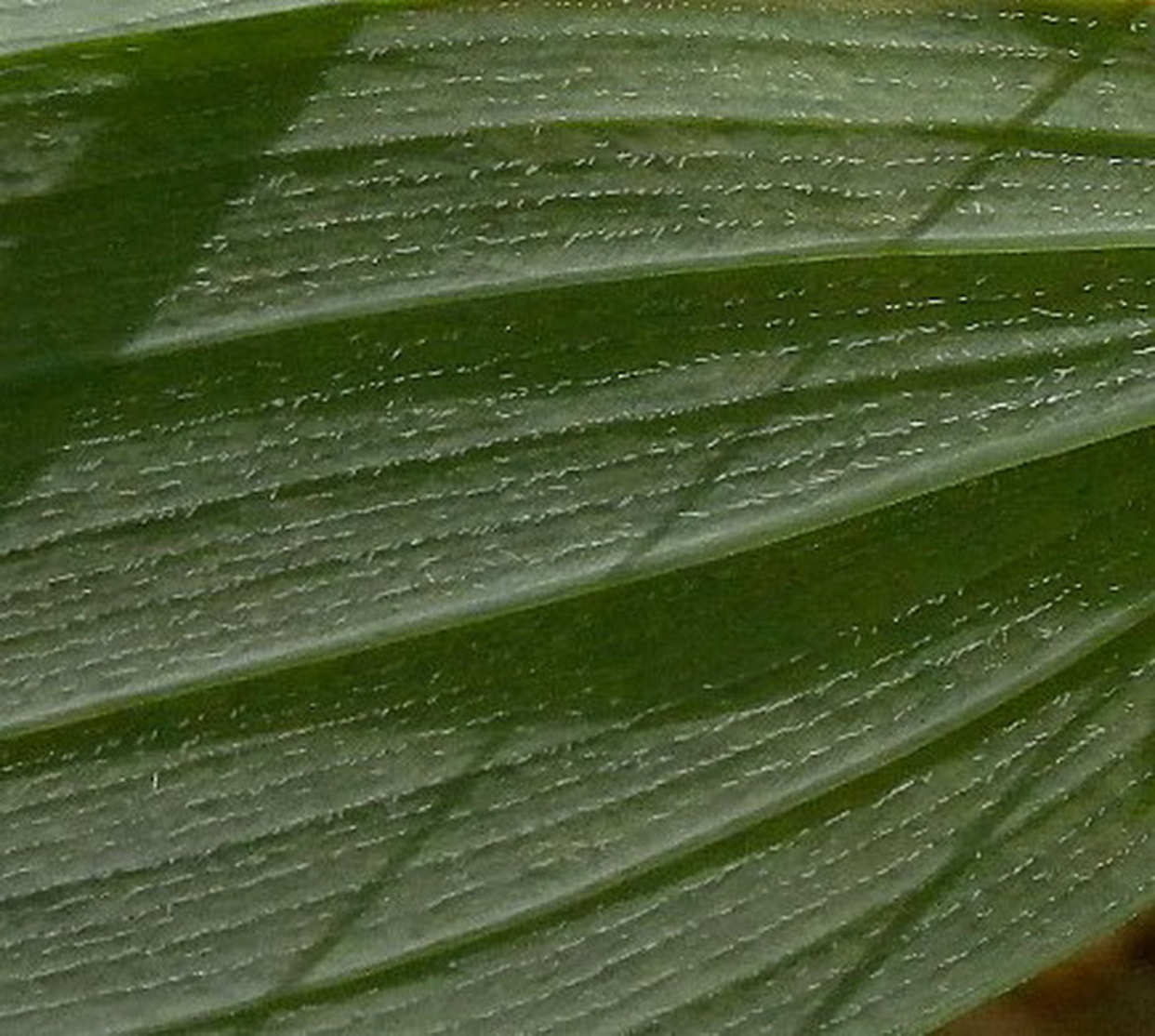
Photographic Location: A moist sandy woodland at the Indiana Dunes State Park in NW Indiana.
Comments: This species can be easily confused with the more common Polygonatum commutatum (Smooth Solomon's Seal). Hairy Solomon's Seal tends to be a smaller plant that produces fewer flowers and berries underneath its leaves (usually only 1-2 flowers or berries per leaf). It also has a tendency to bloom a little earlier in the year than the latter plant. However, the most distinctive characteristics of Hairy Solomon's Seal are 1) the short fine hairs along the veins of its leaf undersides, and 2) the warty filaments of its flowers.
The blooming period occurs from mid- to late spring, lasting about 3 weeks. During the summer, the flowers are replaced by berries. At maturity, these berries are dark blue-violet to black, globoid in shape, and often glaucous; they are 6-9 mm. across. The interior of these berries is fleshy with several seeds. Individual seeds are 1.5-3.0 mm. long, globoid in shape, and either tan or straw-colored. The root system has knotty rhizomes up to ½" thick. Small clonal colonies are often produced from these rhizomes.
Cultivation: The preference is partial sun to medium shade, moist conditions, and soil containing either loam or sandy loam with decaying organic matter. Most growth and development occurs during the cool weather of spring.

Range & Habitat: The native Hairy Solomon's Seal is rare in northern Illinois, while in the rest of the state it is absent (Distribution Map). It is state-listed as 'endangered.' Illinois lies along the southern range limit of this species (excluding mountainous areas in the Appalachians). Habitats include moist to mesic woodlands, sandy woodlands, and lower slopes of forested sand dunes near Lake Michigan. In Illinois, Hairy Solomon's Seal is found in higher quality natural areas.
Faunal Associations: The flowers attract the Ruby-throated Hummingbird, honeybees, bumblebees, and probably other bees. These floral visitors feed primarily on the nectar, although some of the bees also collect pollen for their larvae. A small number of insects feed destructively on the foliage and plant juices of Polygonatum spp. (Solomon's Seal species). These insects include the aphids Catamergus kickapoo and Macrosiphum gei, the thrips Ctenothrips bridwelli, and caterpillars of the moth Clepsis melaleucana (Black-Patched Clepsis). The berries are probably eaten by such woodland birds as the Ruffed Grouse, various thrushes, and the Veery. These birds spread the seeds to new areas. White-tailed Deer occasionally graze on the foliage of Solomon's Seal species.

Photographic Location: A moist sandy woodland at the Indiana Dunes State Park in NW Indiana.
Comments: This species can be easily confused with the more common Polygonatum commutatum (Smooth Solomon's Seal). Hairy Solomon's Seal tends to be a smaller plant that produces fewer flowers and berries underneath its leaves (usually only 1-2 flowers or berries per leaf). It also has a tendency to bloom a little earlier in the year than the latter plant. However, the most distinctive characteristics of Hairy Solomon's Seal are 1) the short fine hairs along the veins of its leaf undersides, and 2) the warty filaments of its flowers.
0
0
文章
Miss Chen
2018年05月27日

Description: This herbaceous perennial wildflower is ¾–1½' tall and unbranched. It consists of a central stem with 3 terminal leaves; a mature plant will produce a single stalked flower. The central stem is terete, glabrous, and pale green or pale reddish-green. The terminal leaves are arranged in a whorl at the apex of this stem. Each leaf is up to 6" long and 5" across; it is oval-ovate or oval in shape, medium green, and glabrous. Each leaf has smooth margins and parallel primary veins.
The single flower spans about 3-4" across on a stalk about 1-3" long. This stalk is ascending or erect; the flower is held above the leaves and usually leans to the side (but doesn't droop downward). Each flower consists of 3 white petals, 3 green sepals, a central white ovary, 6 stamens, and 3 stigmas. The petals are ovate-obovate, widely spreading, and usually longer than the sepals; they often become light pink with age. The sepals are lanceolate and widely spreading. The dull yellow stigmas are slender and either straight or slightly recurved. The blooming period occurs from mid- to late spring and lasts about 3 weeks. Each flower is replaced by a 6-angled seed capsule that becomes dark with age; it eventually splits open to release the seeds. The root system consists of a vertical rootstock with fibrous roots; spreading rhizomes are also produced. Occasionally, thisDistribution Map wildflower forms loose colonies of variable size.
Cultivation: Dappled sunlight or light shade is preferred during the spring; later in the year, more shade is tolerated. The soil should be rich, loamy, rather loose, and evenly moist; a surface layer of leaves and other decaying organic material is desirable. This wildflower develops very slowly from seed (several years to maturity). It is also possible to propagate this species from vegetative offsets of the rhizomes, but this takes time to develop as well.
Range & Habitat: The native Large-Flowered Trillium is occasional in NE Illinois, while in other areas of the state it is uncommon or absent. Populations of this species are stagnant or declining in Illinois; it is somewhat more common further to the east and northeast of the state. Habitats include rich deciduous woodlands, swamps, and shaded riverbanks. Occasionally, Large-Flowered Trillium is cultivated in shade gardens, but it is expensive and difficult to obtain; wild-collected plants should be avoided.
Faunal Associations: As showy as they are, the flowers are rarely visited by insects; Graenicher observed a single species, Ceratina dupla (Little Carpenter Bee), sucking nectar and collecting pollen from them. Another small bee, Andrena geranii, was observed to seek shelter in a flower from the rain. The caterpillars of two moths, Euplexia benesimilis (American Angle Shades) and Clepsis melaleucana (Black-Patched Clepsis), occasionally feed on Trillium spp. (trilliums); the latter species is polyphagous. The seeds of this and other trilliums are distributed by ants because of their elaisomes (food appendages). White-Tailed Deer readily browse on the foliage and flowers of trilliums, and they appear to be attracted to Large-Flowered Trillium in particular (possibly because they can easily see the flowers). Where this trillium is abundant, its large leaves can provide significant cover for small mammals.
Photographic Location: A deciduous woodland in Piatt County, Illinois.

Comments: Among the various species of trilliums, this one is probably the most attractive and charismatic. The flowers are very showy and the leaves have a nice glossy surface. The only other species that is similar, Trillium flexipes (White Trillium), has flowers that are a little smaller and more nodding; usually its flowers hang a little above or a little below the leaves. Large-Flowered Trillium has slender stigmas that are straight or slightly recurved, while White Trillium has stout stigmas that are strongly recurved. While there are other white-petaled trilliums in Illinois, their flowers are much smaller in size (2" across or less).
The single flower spans about 3-4" across on a stalk about 1-3" long. This stalk is ascending or erect; the flower is held above the leaves and usually leans to the side (but doesn't droop downward). Each flower consists of 3 white petals, 3 green sepals, a central white ovary, 6 stamens, and 3 stigmas. The petals are ovate-obovate, widely spreading, and usually longer than the sepals; they often become light pink with age. The sepals are lanceolate and widely spreading. The dull yellow stigmas are slender and either straight or slightly recurved. The blooming period occurs from mid- to late spring and lasts about 3 weeks. Each flower is replaced by a 6-angled seed capsule that becomes dark with age; it eventually splits open to release the seeds. The root system consists of a vertical rootstock with fibrous roots; spreading rhizomes are also produced. Occasionally, thisDistribution Map wildflower forms loose colonies of variable size.
Cultivation: Dappled sunlight or light shade is preferred during the spring; later in the year, more shade is tolerated. The soil should be rich, loamy, rather loose, and evenly moist; a surface layer of leaves and other decaying organic material is desirable. This wildflower develops very slowly from seed (several years to maturity). It is also possible to propagate this species from vegetative offsets of the rhizomes, but this takes time to develop as well.
Range & Habitat: The native Large-Flowered Trillium is occasional in NE Illinois, while in other areas of the state it is uncommon or absent. Populations of this species are stagnant or declining in Illinois; it is somewhat more common further to the east and northeast of the state. Habitats include rich deciduous woodlands, swamps, and shaded riverbanks. Occasionally, Large-Flowered Trillium is cultivated in shade gardens, but it is expensive and difficult to obtain; wild-collected plants should be avoided.
Faunal Associations: As showy as they are, the flowers are rarely visited by insects; Graenicher observed a single species, Ceratina dupla (Little Carpenter Bee), sucking nectar and collecting pollen from them. Another small bee, Andrena geranii, was observed to seek shelter in a flower from the rain. The caterpillars of two moths, Euplexia benesimilis (American Angle Shades) and Clepsis melaleucana (Black-Patched Clepsis), occasionally feed on Trillium spp. (trilliums); the latter species is polyphagous. The seeds of this and other trilliums are distributed by ants because of their elaisomes (food appendages). White-Tailed Deer readily browse on the foliage and flowers of trilliums, and they appear to be attracted to Large-Flowered Trillium in particular (possibly because they can easily see the flowers). Where this trillium is abundant, its large leaves can provide significant cover for small mammals.
Photographic Location: A deciduous woodland in Piatt County, Illinois.

Comments: Among the various species of trilliums, this one is probably the most attractive and charismatic. The flowers are very showy and the leaves have a nice glossy surface. The only other species that is similar, Trillium flexipes (White Trillium), has flowers that are a little smaller and more nodding; usually its flowers hang a little above or a little below the leaves. Large-Flowered Trillium has slender stigmas that are straight or slightly recurved, while White Trillium has stout stigmas that are strongly recurved. While there are other white-petaled trilliums in Illinois, their flowers are much smaller in size (2" across or less).
1
0
文章
Miss Chen
2018年05月27日

Description: This herbaceous perennial plant is about 1½–2' tall; it consists of a central stalk with 3 spreading terminal leaves. The stalk is light green and hairless. The leaves are up to 6½" long and across; they are broadly obovate or broadly rhombic-oval, smooth along the margins, and hairless. The base of each leaf is wedge-shaped, while the terminal end tapers to a blunt tip. The major veins of each leaf are parallel; there are also branching side veins. A mature plant produces a single flower on a nodding peduncle about 1–2½" long. This flower is about 2" across, consisting of 3 white spreading petals, 3 green sepals, 6 stamens (anthers & filaments), and a creamy central ovary. The pale yellow anthers are twice as long as their filaments. At the tip of the ovary, there are 3 recurved stigmas. Only rarely are the petals of the flowers brownish purple. The flower hangs from its peduncle a little above or a little below the leaves.
The blooming period occurs from mid- to late spring. The seed capsule that replaces the flower is 6-angled; it splits open at maturity to release the seeds. The foliage withers away during the summer. The vertical central root is slightly swollen near the base of the plant; it branches into secondary fibrous roots. Small vegetative colonies are occasionally produced from spreading rhizomes.
Cultivation: The preference is dappled sunlight during the spring, followed by light to medium shade. The soil should be evenly moist, fertile, and loamy, with a layer of decaying leaves on its surface to protect the plant from drying out. Trilliums are slow to develop from seed and take many years to reach maturity. Most growth and development occurs during the spring before the canopy trees fully leaf out.

Range & Habitat: The native White Trillium is occasional in the northern half of Illinois, and uncommon or absent in the southern half of the state (see Distribution Map). Habitats include rich deciduous woodlands, wooded slopes, large shady ravines, and rocky bluffs. This species is found in high quality woodlands where the original ground flora is still intact.
Faunal Associations: Few insects visit the flowers of Trillium spp. (trilliums), even though their flowers are rather showy; records for this particular species have not been found. The caterpillars of the moths Clepsis melaleucana (Black-Patched Clepsis) and Euplexia benesimilis (American Angle Shades) occasionally feed on the foliage of Trilliums. The seeds are distributed by ants because of their food appendages. White-Tailed Deer readily graze on the foliage of trilliums; they seem to prefer it.
Photographic Location: Deciduous woodlands at Shades State Park, Pine Hills State Nature Preserve, and the Potholes in west-central Indiana.

Comments: Other common names for this species are the Declined Trillium and Drooping Trillium. This is one of the white-flowered trilliums (Trillium spp.) in Illinois. It is much larger and blooms later than Trillium nivale (Snow Trillium), and its flowers are less erect and somewhat smaller than those of Trillium grandiflorum (Large-Flowered Trillium). This latter species has straight stigmas, while the stigmas of White Trillium are recurved and spreading. It is easy to confuse this species with Trillium cernuum (Nodding Trillium), which also has white nodding flowers. This latter species has somewhat smaller leaves and flowers, and the peduncles of its flowers are usually shorter (less than 1¼" long). This latter species has anthers that are about the same length as their filaments, while White Trillium has anthers that are about twice as long as their filaments.
The blooming period occurs from mid- to late spring. The seed capsule that replaces the flower is 6-angled; it splits open at maturity to release the seeds. The foliage withers away during the summer. The vertical central root is slightly swollen near the base of the plant; it branches into secondary fibrous roots. Small vegetative colonies are occasionally produced from spreading rhizomes.
Cultivation: The preference is dappled sunlight during the spring, followed by light to medium shade. The soil should be evenly moist, fertile, and loamy, with a layer of decaying leaves on its surface to protect the plant from drying out. Trilliums are slow to develop from seed and take many years to reach maturity. Most growth and development occurs during the spring before the canopy trees fully leaf out.

Range & Habitat: The native White Trillium is occasional in the northern half of Illinois, and uncommon or absent in the southern half of the state (see Distribution Map). Habitats include rich deciduous woodlands, wooded slopes, large shady ravines, and rocky bluffs. This species is found in high quality woodlands where the original ground flora is still intact.
Faunal Associations: Few insects visit the flowers of Trillium spp. (trilliums), even though their flowers are rather showy; records for this particular species have not been found. The caterpillars of the moths Clepsis melaleucana (Black-Patched Clepsis) and Euplexia benesimilis (American Angle Shades) occasionally feed on the foliage of Trilliums. The seeds are distributed by ants because of their food appendages. White-Tailed Deer readily graze on the foliage of trilliums; they seem to prefer it.
Photographic Location: Deciduous woodlands at Shades State Park, Pine Hills State Nature Preserve, and the Potholes in west-central Indiana.

Comments: Other common names for this species are the Declined Trillium and Drooping Trillium. This is one of the white-flowered trilliums (Trillium spp.) in Illinois. It is much larger and blooms later than Trillium nivale (Snow Trillium), and its flowers are less erect and somewhat smaller than those of Trillium grandiflorum (Large-Flowered Trillium). This latter species has straight stigmas, while the stigmas of White Trillium are recurved and spreading. It is easy to confuse this species with Trillium cernuum (Nodding Trillium), which also has white nodding flowers. This latter species has somewhat smaller leaves and flowers, and the peduncles of its flowers are usually shorter (less than 1¼" long). This latter species has anthers that are about the same length as their filaments, while White Trillium has anthers that are about twice as long as their filaments.
0
0
文章
Miss Chen
2018年05月27日

Description: This herbaceous perennial plant is 1½-3' tall and sparingly branched. The central stem is medium green, terete, and glabrous to slightly hairy, becoming somewhat broader where the bases of leaves wrap around it. On some plants, the central stem has a tendency to zigzag slightly between the alternate leaves. These leaves are up to 12" long, 2" across, and linear-lanceolate or elliptic-lanceolate in shape; they are smooth (entire) and sometimes slightly ciliate along their margins. Because of their length, the leaves have a tendency to arch downward from their bases. The upper leaf surface is dark green and glabrous to short-hairy, while the lower leaf surface is medium green and glabrous to short-pubescent (sometimes there are only minute hairs along the undersides of the veins). Leaf venation is parallel.
Sometimes secondary stems and leaves develop from the axils of the primary leaves. The central stem terminates in a floppy umbel of flowers on slender pedicels. Sometimes umbels of flowers are produced from the axils of the upper leaves or on short secondary stalks. Each flower is about 1" across when it is fully open, consisting of 3 light violet petals (rarely white), 3 medium green sepals, 6 stamens with yellow anthers, and a pistil with a single style. The petals are oval or broadly ovate, while the smaller sepals are ovate and usually hairy. The filaments of the stamens are pale violet; they are densely covered with spidery hairs. The pedicels of the flowers are about ½" long, medium green or reddish purple, and glabrous to hairy. At the base of each umbel of flowers, there is a leafy bract that is opposite from the alternate leaf; this bract is somewhat smaller in size.

The blooming period occurs during the summer, lasting about 1½ months. The flowers are diurnal, opening up during the morning and closing at about noon (although they may remain open longer on cloudy days). Each flower lasts only a single day. Because only a few flowers are in bloom at the same time, the blooming period is fairly long. Afterwards, the flowers are replaced by 3-chambered seed capsules (up to ¼" long); each of these capsules contain several seeds. The seeds are 2-3 mm. long and flattened-ovoid in shape; they have slightly indented centers, from which several fine grooves radiate outward in all directions toward their outer margins. The root system consists of a mass of fleshy fibrous roots, from which clonal offsets are occasionally produced.
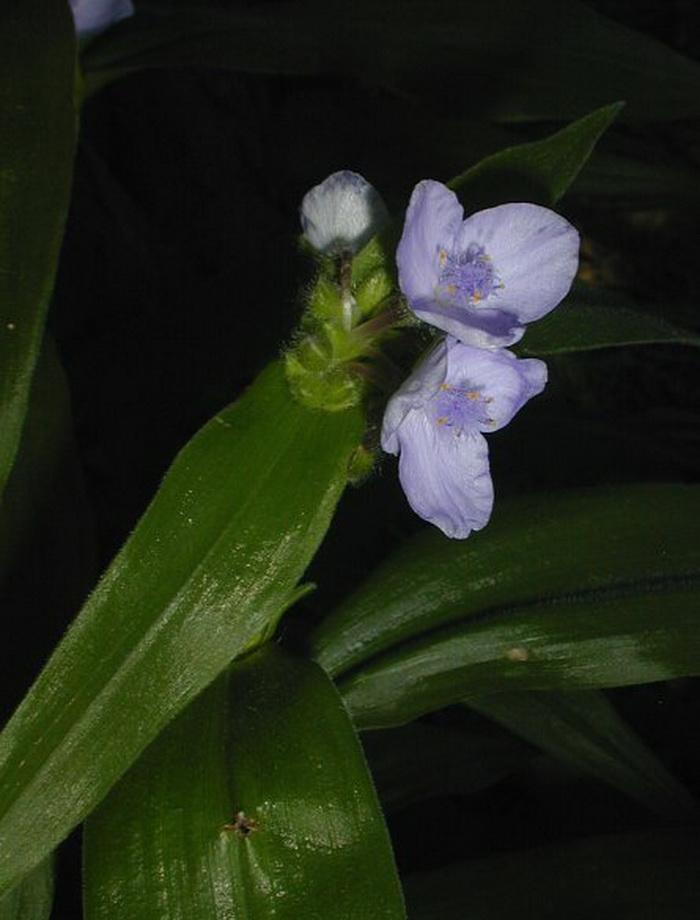
Cultivation: The preference is partial sun to medium shade, moist to mesic conditions, and a fertile loamy soil with decaying organic matter. Like other spiderworts (Tradescantia spp.), this plant is little bothered by insect pests and foliar disease. It adapts well to flower gardens in areas where there is some shade.
Range & Habitat: The native Zigzag Spiderwort occurs occasionally in the southern half of Illinois, while it is rare or absent in the northern half of the state (see Distribution Map). Habitats include rich deciduous woodlands, woodland borders, bases of bluffs, bottoms of large ravines, and shaded areas along streams. Sometimes this plant can be found in more disturbed areas, such as shaded areas along railroads, roads, and corners of yards when they are adjacent to woodlands.

Faunal Associations: The flowers are cross-pollinated by bumblebees primarily. Halictid bees, including green metallic bees, collect pollen from the flowers, while Syrphid flies feed on pollen. Insects that feed destructively on Zigzag Spiderwort include the leaf beetles Paratriarius dorsatus, Oulema collaris, and other Oulema spp.; the stink bugs Acrosternum hilaris, Mormidea lugens, Proxys punctulatus, and Euschistus spp.; and the thrips Frankliniella fusca. The mucilaginous foliage of spiderworts (Tradescantia spp.) is eaten occasionally by the Woodland Box Turtle, Cottontail Rabbit, and White-tailed Deer.
Photographic Location: Underneath the shade of a tree in a flower garden at Urbana, Illinois.
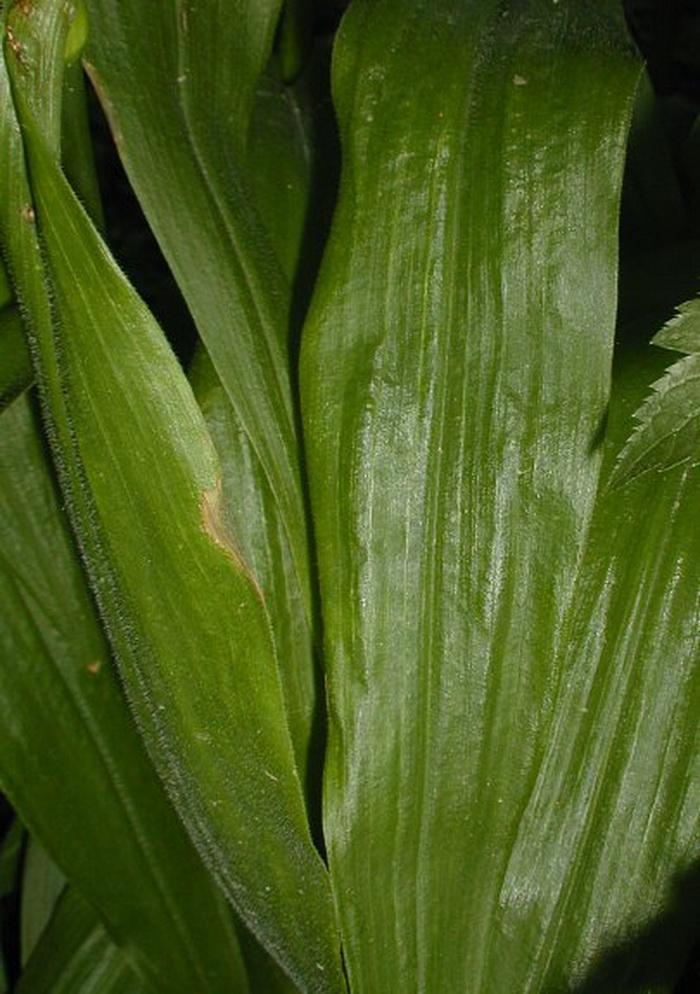
Comments: Of the several spiderwort species (Tradescantia spp.) in Illinois, Zigzag Spiderwort has the broadest leaves (up to 2" across) and they are typically dark green. Other spiderworts within the state have leaves ¾" across or less. Zigzag Spiderwort is better adapted to shady woodland areas than these other species. Another woodland species, Commelina virginica (Virginia Dayflower), has similar leaves, but the petals of its flowers are blue, rather than light violet, and its lower petal is noticeably smaller in size than the upper two. In contrast, the petals of Spiderworts are the same size. Like plant species in the Lily (Liliaceae) and Iris (Iridaceae) families, both spiderworts and dayflowers (Commelina spp.) are monocots, rather than dicots.
Sometimes secondary stems and leaves develop from the axils of the primary leaves. The central stem terminates in a floppy umbel of flowers on slender pedicels. Sometimes umbels of flowers are produced from the axils of the upper leaves or on short secondary stalks. Each flower is about 1" across when it is fully open, consisting of 3 light violet petals (rarely white), 3 medium green sepals, 6 stamens with yellow anthers, and a pistil with a single style. The petals are oval or broadly ovate, while the smaller sepals are ovate and usually hairy. The filaments of the stamens are pale violet; they are densely covered with spidery hairs. The pedicels of the flowers are about ½" long, medium green or reddish purple, and glabrous to hairy. At the base of each umbel of flowers, there is a leafy bract that is opposite from the alternate leaf; this bract is somewhat smaller in size.

The blooming period occurs during the summer, lasting about 1½ months. The flowers are diurnal, opening up during the morning and closing at about noon (although they may remain open longer on cloudy days). Each flower lasts only a single day. Because only a few flowers are in bloom at the same time, the blooming period is fairly long. Afterwards, the flowers are replaced by 3-chambered seed capsules (up to ¼" long); each of these capsules contain several seeds. The seeds are 2-3 mm. long and flattened-ovoid in shape; they have slightly indented centers, from which several fine grooves radiate outward in all directions toward their outer margins. The root system consists of a mass of fleshy fibrous roots, from which clonal offsets are occasionally produced.

Cultivation: The preference is partial sun to medium shade, moist to mesic conditions, and a fertile loamy soil with decaying organic matter. Like other spiderworts (Tradescantia spp.), this plant is little bothered by insect pests and foliar disease. It adapts well to flower gardens in areas where there is some shade.
Range & Habitat: The native Zigzag Spiderwort occurs occasionally in the southern half of Illinois, while it is rare or absent in the northern half of the state (see Distribution Map). Habitats include rich deciduous woodlands, woodland borders, bases of bluffs, bottoms of large ravines, and shaded areas along streams. Sometimes this plant can be found in more disturbed areas, such as shaded areas along railroads, roads, and corners of yards when they are adjacent to woodlands.

Faunal Associations: The flowers are cross-pollinated by bumblebees primarily. Halictid bees, including green metallic bees, collect pollen from the flowers, while Syrphid flies feed on pollen. Insects that feed destructively on Zigzag Spiderwort include the leaf beetles Paratriarius dorsatus, Oulema collaris, and other Oulema spp.; the stink bugs Acrosternum hilaris, Mormidea lugens, Proxys punctulatus, and Euschistus spp.; and the thrips Frankliniella fusca. The mucilaginous foliage of spiderworts (Tradescantia spp.) is eaten occasionally by the Woodland Box Turtle, Cottontail Rabbit, and White-tailed Deer.
Photographic Location: Underneath the shade of a tree in a flower garden at Urbana, Illinois.

Comments: Of the several spiderwort species (Tradescantia spp.) in Illinois, Zigzag Spiderwort has the broadest leaves (up to 2" across) and they are typically dark green. Other spiderworts within the state have leaves ¾" across or less. Zigzag Spiderwort is better adapted to shady woodland areas than these other species. Another woodland species, Commelina virginica (Virginia Dayflower), has similar leaves, but the petals of its flowers are blue, rather than light violet, and its lower petal is noticeably smaller in size than the upper two. In contrast, the petals of Spiderworts are the same size. Like plant species in the Lily (Liliaceae) and Iris (Iridaceae) families, both spiderworts and dayflowers (Commelina spp.) are monocots, rather than dicots.
0
0
文章
权问薇
2018年05月27日


1.制作花束模型
在选好手捧花材料之后,首先我们要用绿色的枝叶做出一个大致的手捧花模型,至于用什么样的叶子,那就要看个人爱好了。接着就要开始采用一些比较高挑纤细的花朵,来设计一些手捧花的形状,这里建议在设计的时候最好是不对称的形状,要让其中的一方比另一方高一点最好。

2.添加手捧花朵
在添加手捧花朵的时候,要添加多少这个就要看自己的个人爱好了。如果花束看起来比较小的,就可以在里面加上几朵大小中等的花朵。在加花的时候,一定要注意好花束的色彩均衡,另外在这个过程里面,也是要保持花卉搭配的层次性,防止手捧花看起来太近就不好看了。

3.添加配材
在把主花做好了之后,这时候我们可以为自己的手捧花加一点特别的花朵,这个也是根据自己喜好的。这样就可以给新娘手捧花带来美丽的外观。而且用这些花朵为整个手捧花增加了重量和内容。

4.修整花束
接着就是可以把自己的花束进行一定的修整,这个也是要根据自己的喜好来确定这个长度的。

5.进行固定
在修整后,我们就可以用胶带来把花束的根部给绑住,这样就可以给它固定起来,方便了一会用丝带进行包裹。但是在绑的时候尽量不要绑的太靠上面,不然就会把花束的形状给破坏了。所以在绑的时候一定要注意了,也不能太紧了,不然出来的效果也是不让人满意的。

6.丝带包裹
在固定之后,这时候我们就可以用漂亮的丝带来包裹自己的花束了。一般都是用自己喜欢的颜色去包裹,这样让我们的新娘手捧花更加的有意义。
0
1
文章
Miss Chen
2018年05月26日

Description: This perennial wildflower is 1½–3' tall. Each plant has a central stem that develops from the rootstock (less often, there are 2-3 such stems), which branches from below the middle. During the flowering period, short secondary stems develop from the axils of the leaves. These stems are terete, mostly light green, and pubescent; sometimes they have longitudinal ridges. The alternate leaves are up to 3½" long and 1" across; they are lanceolate, oblanceolate, or narrowly ovate with margins that are slightly toothed or smooth. The upper surface of each leaf is medium green and hairless, while the lower surface is light green and finely short-pubescent. Sometimes there are longer hairs along the central vein on the underside of each leaf. The leaves are sessile against their stems and their outer tips are somewhat blunt.
The upper stems terminate in elongated panicles of flowerheads. Each flowerhead spans about ½" across, consisting of 15-25 white ray florets and a similar number of disk florets. The disk florets are initially pale yellow, but they later become reddish purple; each disk floret is tubular in shape with 5 spreading lobes along its upper rim. Surrounding the base of each flowerhead, there is an overlapping series of small floral bracts (phyllaries). These floral bracts are linear in shape, evenly green from top to bottom, and appressed or slightly spreading. Each flowerhead has a short peduncle up to 1" long. In addition to the flowerheads, the branches of the panicle have numerous leafy bracts. These leafy bracts are similar in appearance to the leaves, except smaller in size. The blooming period occurs from late summer into the fall and lasts about 1-2 months. Each flowerhead is replaced by a dense cluster of small achenes. Each achene is bullet-shaped with a small tuft of white hairs at its apex. The achenes are distributed by the wind. The root system is fibrous and long-rhizomatous. Small colonies of plants are occasionally formed.
Cultivation: The preference is partial or dappled sunlight, moist to mesic conditions, and a fertile loamy soil. Other kinds of soil are also tolerated.

Range & Habitat: The native Ontario Aster is occasional to locally common throughout Illinois (see Distribution Map). Habitats include open woodlands, woodland openings, woodland borders, partially shaded cliffs, areas along woodland paths, powerline clearances in wooded areas, low areas along woodland streams, savannas, moist meadows, and abandoned fields. This aster benefits from disturbance if it reduces excessive shade from canopy trees.
Faunal Associations: The nectar and/or pollen attract various insects, including bumblebees, little carpenter bees (Ceratina spp.), leaf-cutting bees (Megachile spp.), Halictid bees, Syrphid flies, and butterflies. A long-horned bee, Melissodes dentriventris, is an oligolectic floral visitor of this and other asters (Symphyotrichum spp.). These insects cross-pollinate the flowers. Other insects, including aphids, plant bugs, leaf beetles, etc., feed destructively on asters (see Insect Table); there are also a large number of moth caterpillars that feed on various parts of asters (see Moth Table). The Ruffed Grouse and Wild Turkey feed on the leaves and seeds of these plants to a limited extent; White-Tailed Deer and Cottontail Rabbits also feed on the foliage to a limited extent.
Photographic Location: A powerline clearance at Busey Woods in Urbana, Illinois.
Comments: This aster has a rather ordinary appearance and it is often omitted in many wildflower guides. Ontario Aster (Symphyotrichum ontarionis) resembles several other asters (Symphyotrichum spp.) with small white flowerheads and they often occur in the same or similar habitats. In general, Ontario Aster can be distinguished from these other species by the even pubescence of its stems and the even canescence (short fine pubescence) on the underside of its leaves. Other similar asters have stems with lines of hair and the undersides of their leaves are either hairy along the major veins or hairless. The flowerheads of Ontario Aster have 15-25 ray florets and its floral bracts are evenly green from top to bottom. Other similar asters have fewer ray florets (10-15) or their floral bracts have a diamond-shaped pattern near their tips that is dark green. Ontario Aster also has an abundance of leafy green bracts along the branches of its panicles, while the bracts of other asters are smaller in size and more scale-like in appearance. Sometimes Ontario Aster hybridizes with similar species of asters, which increases the difficulty of identification. A scientific synonym of this species is Aster ontarionis.
The upper stems terminate in elongated panicles of flowerheads. Each flowerhead spans about ½" across, consisting of 15-25 white ray florets and a similar number of disk florets. The disk florets are initially pale yellow, but they later become reddish purple; each disk floret is tubular in shape with 5 spreading lobes along its upper rim. Surrounding the base of each flowerhead, there is an overlapping series of small floral bracts (phyllaries). These floral bracts are linear in shape, evenly green from top to bottom, and appressed or slightly spreading. Each flowerhead has a short peduncle up to 1" long. In addition to the flowerheads, the branches of the panicle have numerous leafy bracts. These leafy bracts are similar in appearance to the leaves, except smaller in size. The blooming period occurs from late summer into the fall and lasts about 1-2 months. Each flowerhead is replaced by a dense cluster of small achenes. Each achene is bullet-shaped with a small tuft of white hairs at its apex. The achenes are distributed by the wind. The root system is fibrous and long-rhizomatous. Small colonies of plants are occasionally formed.
Cultivation: The preference is partial or dappled sunlight, moist to mesic conditions, and a fertile loamy soil. Other kinds of soil are also tolerated.

Range & Habitat: The native Ontario Aster is occasional to locally common throughout Illinois (see Distribution Map). Habitats include open woodlands, woodland openings, woodland borders, partially shaded cliffs, areas along woodland paths, powerline clearances in wooded areas, low areas along woodland streams, savannas, moist meadows, and abandoned fields. This aster benefits from disturbance if it reduces excessive shade from canopy trees.
Faunal Associations: The nectar and/or pollen attract various insects, including bumblebees, little carpenter bees (Ceratina spp.), leaf-cutting bees (Megachile spp.), Halictid bees, Syrphid flies, and butterflies. A long-horned bee, Melissodes dentriventris, is an oligolectic floral visitor of this and other asters (Symphyotrichum spp.). These insects cross-pollinate the flowers. Other insects, including aphids, plant bugs, leaf beetles, etc., feed destructively on asters (see Insect Table); there are also a large number of moth caterpillars that feed on various parts of asters (see Moth Table). The Ruffed Grouse and Wild Turkey feed on the leaves and seeds of these plants to a limited extent; White-Tailed Deer and Cottontail Rabbits also feed on the foliage to a limited extent.
Photographic Location: A powerline clearance at Busey Woods in Urbana, Illinois.
Comments: This aster has a rather ordinary appearance and it is often omitted in many wildflower guides. Ontario Aster (Symphyotrichum ontarionis) resembles several other asters (Symphyotrichum spp.) with small white flowerheads and they often occur in the same or similar habitats. In general, Ontario Aster can be distinguished from these other species by the even pubescence of its stems and the even canescence (short fine pubescence) on the underside of its leaves. Other similar asters have stems with lines of hair and the undersides of their leaves are either hairy along the major veins or hairless. The flowerheads of Ontario Aster have 15-25 ray florets and its floral bracts are evenly green from top to bottom. Other similar asters have fewer ray florets (10-15) or their floral bracts have a diamond-shaped pattern near their tips that is dark green. Ontario Aster also has an abundance of leafy green bracts along the branches of its panicles, while the bracts of other asters are smaller in size and more scale-like in appearance. Sometimes Ontario Aster hybridizes with similar species of asters, which increases the difficulty of identification. A scientific synonym of this species is Aster ontarionis.
0
0
文章
权问薇
2018年05月26日


1.灌溉
在它生长的时候,水是很重要的。一般我们都要对它进行适当的补水,至于量的多少和间隔的时间,是要看下它自身的生长情况,如果是在生长快速的时期的话,就可以多给一点水,另外除了要看植株生长状况,有时候天气和土质等外界因素也是对水量有很大决定性的。所以一定要适量而行。另外在遇到水量过多的时候,需要对它进行一定的排水,这样就可以改善土质的透气性,让植物更好生长,避免了积水的存在。

2.除草
除了水分的需要,进行一定的除草,对于植物也是很有帮助的。把草除掉了,就会相对的减少了一些养分的消耗,还有效的预防了一些害虫的发生。另外我们在除草的时候,势必会松动土,这样就可以让土的透气性变强,利于了根部的呼吸,让植株正常代谢,生长的也会更加好。
3.间苗
一般田间的小苗长到了一定时候,就会有一些过密的小苗丛生在一起,争夺养分,所以这时候我们就需要适当的间苗,把那些过密小苗及时拔出除,这样就可以让营养更充足,利于小苗快速生长为植株。
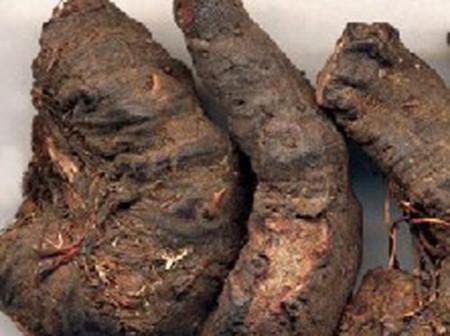
4.遮阴
它本身是一种喜阴的植物,在夏天的时候为了防止受到强光照射,所以就需要进行适当的遮光操作,这样才不会遭受暴晒。
5.修剪
有时候,植物会生长的太快,所以我们要对枝条进行修剪。可以改善通风条件,让水和营养更好分配,避免了一些养分的消耗,就可以让其生长更好,相应的产量也会随之增加。
0
0
文章
权问薇
2018年05月26日


1、底肥
施肥其实是有规则的,如果说我们单纯为了施肥而施肥,那白菊非常有可能因为我们的施肥而死去。但是如果我们仔细地照料它,把握好施肥的原则,那就能把我们的它照料的很好。
底肥当然也是有讲究的,我们最好使用有机肥料,比如说使用人的粪便或者说使用鸡鸭粪便,都很方便。除此之外我们还要使用磷肥来协助。
2、发棵肥
假如我们已经成功地把它种活了,之后就要施加一些肥料来促使它发棵,帮助它更好的生长,这时候我们就要使用发棵肥了。发棵肥的分量很重要,但也不需要太多量。发棵肥具体使用的也是人粪尿,此外可以通过兑水来稀释肥料的浓度,防止烧苗。
3、压条肥
在杭白菊成功发棵之后我们还要使用一些肥料来促使它压条,这时候就不能单纯使用人粪尿了,我们还需要使用一些尿素,栏肥也是很重要的。在进行之前我们一定要在两边都铺上栏肥。

4、分枝肥
分枝肥是必须要使用的,这时候我们有两种选择,一是使用人粪尿,二是使用复合肥,使用人粪尿的量必须很多,每一亩就要两三百斤,而复合肥的效果显著一点,就不要求那么大的量,只要使用二十斤左右在一亩上就完全能够促使它分枝了。当然,分枝肥最好在八月份的时候用。因为一般都是跟在打顶之后,而打顶在八月,所以分枝自然而然也就是在八月份使用了。
5、蕾肥
蕾肥是在分枝肥后一月使用,也就是说是在九月上中旬,在这一段时期它会进入生长期,生长会异常茂盛,所以我们必须要使用非常多的肥料来促使它生长得更好,我们可以使用尿素或者复合肥,分量也不用很多。

0
3








